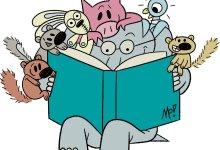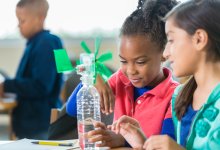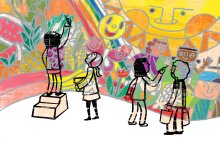Creativity
Not sure where to start with teaching creativity? Discover how to ignite students’ interests and passions. Then, stand back, and watch great things emerge.
Bringing High School Students and Kindergartners Together to Make Art
A look at how teachers can have students collaborate across grades on an art project that promotes creativity and teamwork.8.3kYour content has been saved!
Go to My Saved Content.Teaching Elementary Students to Use Audio and Graphic Design Tools
Teachers can amplify students’ creativity by showing them how to demonstrate their learning with multimedia applications.Your content has been saved!
Go to My Saved Content.The Powerful Effects of Drawing on Learning
The science is clear: Drawing beats out reading and writing to help students remember concepts.1.5MYour content has been saved!
Go to My Saved Content.19 Highly Engaging End-of-Year Activities
Teachers can help students end the year on a high note with activities that remind them how much they’ve learned in class.8 AI Tools That Can Help Generate Ideas for Your Classroom
These educator-tested platforms can help you create instructional materials and develop ideas for lessons—and they require little to no tech savvy.Mo Willems on the Lost Art of Being Silly
The author of Don’t Let the Pigeon Drive The Bus! chats with us about creativity, drawing as empathy, and letting kids “do 51 percent of the work.”554.6kYour content has been saved!
Go to My Saved Content.Your Student Finished Early—Now What?
These extension activities for all grades will help teachers keep fast finishers engaged in meaningful work.5 Movement-Based Social Studies Activities
Introducing movement into lessons can help students maintain focus and attention and boost engagement in learning.7.6kYour content has been saved!
Go to My Saved Content.The Spatially Gifted—Our Future Architects and Engineers—Are Being Overlooked
Though they have the potential to excel in many fields, we’re neglecting a large body of students with a unique set of skills.306kYour content has been saved!
Go to My Saved Content.Encouraging Students to Use Notes for Sense-Making
Middle school teachers can use these strategies to help students learn how to get the most value out of their notes.37.9kYour content has been saved!
Go to My Saved Content.4 Ways to Develop Creativity in Students
Creativity is a valuable skill, and there are common strategies teachers can use to help students develop it.310.8kYour content has been saved!
Go to My Saved Content.Transforming a School Through Arts Integration
Structuring a school around the arts can help students excel academically and develop social and emotional skills.270.6kYour content has been saved!
Go to My Saved Content.Using Tech Tools to Amplify Classroom Thinking Routines
Integrating digital tools empowers students with choice, while making thinking increasingly visible and collaborative—creating a more accessible and dynamic classroom culture.9.8kYour content has been saved!
Go to My Saved Content.13 Formative Assessments That Inspire Creativity
Sometimes mixing in formative assessments that go a step beyond exit slips and low-stakes quizzes can inject some fun—and creativity—into learning.103.1kYour content has been saved!
Go to My Saved Content.How Puppets Can Help Kids Express Emotions
Using simple strategies acted out by puppets, students learn social and emotional skills that help them calm themselves, identify their feelings, and connect with others.86.5kYour content has been saved!
Go to My Saved Content.













